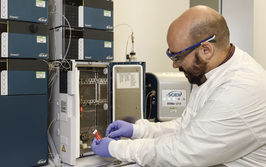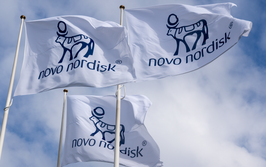
Foresight is 20/20: Lessons Learned with Claudia Zylberberg
Claudia uncovered a gap in the market for high quality ancillary materials during her time in the human plasma industry – and combined that with her belief in the future of cell and gene therapies to found Akron Biotech. Here, she reveals the lessons learned along the way and offers her perspective on the now booming advanced therapies industry.
A gap in the market is good, but a gap in an emerging market is better
I am originally from Buenos Aires, Argentina, where I began my doctoral work, which eventually became a cross-institutional PhD project that took me to the University of British Columbia in Vancouver. Following a move to the United States, I completed two postdocs in Florida before taking a job in the human plasma industry with a company called Nabi Pharmaceuticals, where I worked in bioinformatics and recombinant protein development.
At Nabi, we were working on recombinant vaccines for S. Aureus. One of the critical components used during the manufacturing process, an enzyme, was causing a number of quality-related problems. I went to visit the vendor, and they told me that they couldn’t manufacture it at a higher grade or in a more stringent environment to improve its consistency because the cost was too high and there wasn’t the market for it. Essentially, it was “take it or leave it” – and we couldn’t make the vaccine without the enzyme. I realized then and there that there was a gap in the market for reliable, high-quality materials for the production of biologics and advanced therapies, so I left Nabi to set up Akron. While Akron was getting off the ground, I actually co-founded a stem cell bank with the idea that, in the future, you might be able to make use of younger, and potentially healthier, stem cells. Even then, I was excited – and literally banking on – the future of cell and gene therapy. It was clear to me that the field of regenerative medicine was about to take off in earnest, and that for these therapies to be successful, the market would need high quality ancillary materials. Akron has been growing steadily since 2006 on the hypothesis that high quality ancillary materials would be critical to the clinical and commercial success of these life-saving therapies.
Never underestimate the importance of quality – especially for living therapies
When I started Akron in 2006, the industry was still in its infancy. Since then, and especially with the first CAR-T approvals, I have seen the industry evolve to the point where the scientific questions are being answered. There is a tremendous amount of excellent research driving the field forward, and we have seen some of these early findings yield incredible clinical advances. In many ways, the debate has now moved to the important questions of how we can reduce costs while maintaining high quality standards, thereby ensuring that patients have access to safe and effective therapies. Ancillary materials play a crucial role when it comes to cost and quality.
At Akron, we develop and manufacture ancillary materials as well as provide specialized services to accelerate the development and commercialization of advanced therapies. Our aim is and has always been to develop and manufacture high quality products that we think are, or will be, essential for the industry’s continued growth.
I was recently on a panel where a representative of the FDA articulated just why the quality element is so important. He pointed out that cell therapy products cannot be sterilized, which means that what you put into the manufacturing process is crucial to the final product’s quality. And we see this idea reflected in FDA guidance, which discusses the need for greater detail on the source, quality and manufacturing of ancillary materials. And this trend is global. Indeed, other national regulatory agencies are pondering the same sorts of questions, and in the transnational arena, ISO has put together an ancillary material standard (a technical document) that we, along with others from Europe, Asia and the US, helped to create.
But quality is also closely tied to cost. Today, we’re seeing a great deal of interaction between developers’ supply chain teams and their suppliers – it’s a much closer and stronger relationship than in the past. And that’s because some of the components that go into a cell therapy are extremely difficult to find, so sourcing isn’t easy. And there’s a lot of risk involved because the quality standards haven’t yet caught up and aren’t set up for the fact that these new products can’t be sterilized. Manufacturers must build expensive and time-consuming measures into their supply chains to mitigate that risk. We are all walking a fine line, trying to increase quality while containing cost. Ancillary materials will thus play an important role in streamlining manufacturing and reducing costs – even I had not appreciated how important they would become when we first started the company.

Ask yourself: what legacy will I leave?
I spend a lot of time working with industry organizations and regulatory bodies. Sitting around tables, sharing thoughts, listening and challenging one another is what will make the industry grow. The industry as a whole is new and we need to work together to facilitate its development.
I love what I do and I think passion is vitally important. The field has a great deal of promise – especially for patients who don’t have many options. One of my main drivers is thinking about what legacy I will leave. In the early days of the cell and gene therapy industry, I was frustrated because it seemed like everyone was speaking a different language. I felt that I needed to participate in the discussions by sitting on advisory boards and writing papers in an attempt to harmonize standards and practices in the industry. And I hope that bringing the industry together so that we can move forward faster will be part of my legacy.
It’s also about being part of something bigger than yourself. I am passionate about education, whether it be for scientists, business leaders or patients; this is why I chose to get involved in the newly formed Alliance of Regenerative Medicine Foundation, whose primary purpose is to educate. But this also extends to the next generation: I actually write children’s books about science. One book I published a while back called “You’re Full of Genes” was interesting because it was read by both children (the target audience) and adults, who wanted to learn or brush up on the basics. I believe a more educated public on the science of genes and cells can only help our industry – plus I really enjoy it. I would love to pursue it further (if I had more time!).
Witness the strength of street knowledge
I always knew I was going to set up my own business – it was just a matter of time. In the beginning, I felt a little under-utilized given everything I’d learned during my time in academia. I felt there wasn’t much space to adjust, but once I’d made the switch there was no going back. Industry is a completely different environment to academia and adjusting to it can be challenging – though over time I have learned to really enjoy it. I had to learn business on the fly. I didn’t have time to pursue an MBA when I could’ve used it most – early on, when knowledge and connections are most important to getting a new business off the ground. So I learned the hard way. I’ve picked up some bumps and bruises along the way, but I do believe that business is best learned in practice – on the street. Everything is nice and clean in theory – you don’t truly learn how to run a business when you don’t have any skin in the game.
Be persistent – but don’t bang your head against a wall
I’m proud that I was able to emigrate to the US and make a success of a business – really from scratch. If there’s one thing I’ve learned, it’s that you must persevere. I wanted to give up many times, especially during the economic crisis in 2008. It happened just after we had started the company and there were certainly moments when I thought it might be easier to give up. At these times, you have to be honest with yourself; sometimes you have to move on and admit that what you’re doing isn’t working. But you also have to be sure that it’s for the right reasons. I think success comes from knowing, not hoping, that what you’re doing has great potential, and then persevering through the hard times to make it a reality.
Engaging with Your Peers
Claudia is active within a number of cell and gene therapy industry organizations, including:
- Centre for Commercialization of Regenerative Medicine, Member Board of Directors
- National Academy of Sciences, Member Regenerative Medicine Forum
- International Society for Cell and Gene Therapy (ISCT), Member of the Strategic Advisory Council
- Standards Coordinating Body, Member of the Board
- Alliance of Regenerative Medicine Foundation, Member Board of Directors
- ARM Alliance of Regenerative Medicine, Member of the Board
- BioFlorida, Board of Directors and Co-Chair of the Biobusiness track
- Theradaptive, Advisory Board Member
Claudia Zylberberg: “It’s interesting to see how industry organizations have evolved over the past decade. For example, ISCT used to be made up of hospital-based academics and doctors – usually technical specialists. Now you see an increasing number of industry representatives. The influx of industry people started with smaller companies, usually spun out from universities. Now you see the likes of Novartis and Pfizer at the table because they’re interested in how to incorporate these new therapies into the big pharma model. I think these industry forums are where you really see the industry’s incredible rate of growth and get energized for the road ahead.”

Over the course of my Biomedical Sciences degree it dawned on me that my goal of becoming a scientist didn’t quite mesh with my lack of affinity for lab work. Thinking on my decision to pursue biology rather than English at age 15 – despite an aptitude for the latter – I realized that science writing was a way to combine what I loved with what I was good at.
From there I set out to gather as much freelancing experience as I could, spending 2 years developing scientific content for International Innovation, before completing an MSc in Science Communication. After gaining invaluable experience in supporting the communications efforts of CERN and IN-PART, I joined Texere – where I am focused on producing consistently engaging, cutting-edge and innovative content for our specialist audiences around the world.



















